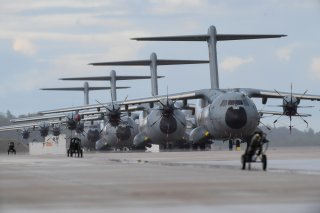The Airbus Future Combat Air System Will Revolutionize Drone Warfare
The system is the brainchild of Airbus and will drop small drones from the back of cargo planes.
Airbus recently showcased their new Future Combat Air System, a radical idea for launching groups of drones out of the back of airborne cargo planes.
“During a recent test, an A400M [military transport aircraft] deployed a drone from its opened rear cargo ramp door whilst airborne, validating its ability to air-launch drones. In the future such unmanned aircraft, called Remote Carriers, can serve as force multipliers for various missions while keeping the pilots out of harm’s way,” said Airbus.
Airbus continued, adding, “manned-unmanned teaming (MUM-T) will allow the Remote Carriers to operate in concert with manned aircraft, opening new fields of tactics to surprise, deceive, deter, saturate and strike opponents.”
The German Air Force partnered with Airbus during the test, an unusual move considering the dilapidated state of the German Air Force and military more broadly.
Later, Airbus stated, “During the A400M flight test, an Airbus-built Do-DT25 drone, acting as a surrogate Remote Carrier, was released over a test range in Northern Germany. Shortly after the launch, the drone’s parachute opened, delivering it safely to the ground. Throughout the test, the drone was connected and transmitting data to the A400M ‘mother aircraft.’”
“This data transfer illustrates how Remote Carriers can be connected to a combat cloud network, providing vital information by serving the role of “eyes and ears” over the battlefield, whilst also enabling them to be tasked by the manned aircraft’s operators during their missions.”
The Americans, Too
The United States Air Force is also experimenting with utilizing cargo and transport airplanes in new ways.
For example, the Air Force Research Laboratory’s Strategic Development Planning and Experimental office’s Rapid Dragon program is experimenting with dropping long-range stand-off munitions from pallets. As a result, airplanes like the C-17 and C-130—without any modifications—could transform into long-range gunships, able to bring a lot of firepower to the fight in a relatively short amount of time.
Though not capable of supersonic sprints like fighter jets, cargo planes can take advantage of long combat ranges—an especially important asset in places like the Indo-Pacific, where the tyranny of distance is difficult to overcome.
The type of ammunition the U.S. Air Force is experimenting with is particularly well-suited to a palletized application. The missiles, called JASSM-ER, are stealthy long-range weapons capable of hitting targets 1,000 kilometers away.
Caleb Larson is a multimedia journalist and defense writer with the National Interest. A graduate of UCLA, he also holds a Master of Public Policy and lives in Berlin. He covers the intersection of conflict, security, and technology, focusing on American foreign policy, European security, and German society for both print and radio. Follow him on Twitter @calebmlarson.
Image: Reuters.

